
10. Once Upon a Time in China
The film that kick-started Hong Kong cinema’s kung-fu renaissance and launched Jet Li towards a future of substandard western action movies. Its subject was already well known to local audiences: Wong Fei-hung was a real person: a turn-of-the-century martial arts master and healer who’s become something of a folk hero. Like Sherlock Holmes or Robin Hood, he’d been portrayed many times before. Jackie Chan played him in Drunken Master, and a long-running Wong Fei-hung film series during the 1950s and 60s gave roles to the fathers of Bruce Lee and Yuen Wo-ping, among many others.
Transposed to 1990s Hong Kong, with the handover from British to Chinese sovereignty on the horizon, this story of a Chinese rebel fighting oppressive colonialist powers had extra resonance. Its British and American baddies are cartoonishly demonised, and the plot is often convoluted to the point of impenetrability, admittedly, but what this film chiefly provides is dazzling, colourful, kinetic, epic, pre-CGI spectacle. Director Tsui Hark, schooled in both the US and Hong Kong, fills the screen with movement and energy. The wire-assisted fight scenes – choreographed by Yuen Wo-ping, inevitably – are ingeniously staged. Earthbound reality is left far behind.
And Li is simply incredible. He’s got gravitas as an actor, but when he’s in action, he really takes some beating. He does it all: fighting with hands, feet, sticks, poles, umbrellas. He kills one baddie with a bullet – without using a gun. But Li is a gymnast, too, pirouetting and somersaulting across the screen with the agility of a cat. He’s surely the most graceful martial artist out there. Those skills come to bear in a jubilantly athletic final duel, which takes place in a warehouse conveniently full of bamboo ladders. It’s one of the most celebrated sequences in martial arts movies, and it leaves you wanting more, of which there is plenty: they made four sequels in the next two years. Steve Rose
9. Yojimbo
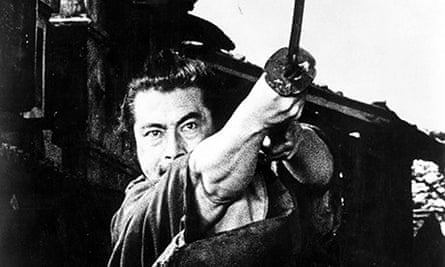
Akira Kurosawa drew upon American pulp sources for Yojimbo’s plot, principally the Hollywood western but also Dashiell Hammett’s broken-city melodrama The Dain Curse. Here a lone, probably disgraced, certainly hungry samurai (Toshiro Mifune, the Wolf to Kurosawa’s Emperor) wanders into a town where two factions are in eternal conflict, glaring at one another from their matching headquarters on opposite sides of the town’s wide, western-like main street. Since each faction lacks a distinguished warrior with whose aid they might tip the balance of power in their favour, they each badly want the newcomer on their side, something the samurai figures out within moments, and exploits throughout the movie.
As the power games play out to their nihilistic, corpse-choked conclusion, Kurosawa demonstrates a mastery of his medium in almost every frame. His sense of spatial relations is beyond compare: panels in interior walls slide away to reveal whole exterior street-scapes and crowd scenes perfectly framed within the smaller new frame. Intimate conversations take place as a turbulent skirmish rages in the deep background center-screen, between the talkers’ faces in the foreground. And what faces! From the moronic warrior with the M-shaped unibrow and the giant wielding a huge mallet to Mifune’s increasingly battered countenance, sardonic, cynical and ever defiant, every single face is at once a landscape and an epic poem unto itself.
Along with all that comes Kurosawa’s furious visual energy, his virtuoso choreography of moving camera and bodies of warring men; and his talent for adding enriching layers of kinetic, elemental motion – rain falling, leaves or smoke blowing in the unceasing winds – to the violence already in play. Yojimbo led to the Italian A Fistful of Dollars, which in time completely remade the American western, completing a circle of international cultural exchange that foreshadows a give-and-take among international filmmakers that we take for granted today. John Patterson
8. A Touch of Zen
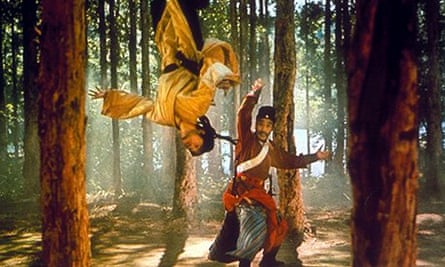
We have A Touch of Zen to thank for Harvey Weinstein’s interest in Asian cinema; it was after Quentin Tarantino screened King Hu’s 1971 wuxia that the mogul began a controversial spending spree in the east that led to his current controversial involvement with Bong Joon-ho’s Snowpiercer. It’s not hard to see why: Hu’s film is unusually epic for the genre, clocking in at over three hours, and made cinema history by being the first Chinese film to win an award at Cannes, missing out on the Palme d’Or but taking home the Technical prize.
A Touch of Zen is most notable nowadays as the template for Ang Lee’s Crouching Tiger, Hidden Dragon, being the 14th century story of an artist, Ku, who encounters a beautiful woman living in a rundown house with her elderly mother. In true wuxia fashion, however, she is not all she seems, and so the story grows, until Ku realises that he is in the middle of a major dynastic war between rival factions. And as the story develops – effortlessly absorbing elements of comedy and romance – so does the spectacle, increasing in scale and scope in ways that would be unimaginable today.
It is these fight sequences that have endured, and although wuxia briefly fell out of favour soon after, it is easy to see Hu’s influence on the hit martial arts films of recent years. More so than Crouching Tiger, A Touch of Zen casts a long shadow over the films of Chinese director Zhang Yimou, whose House Of Flying Daggers directly references Hu’s film in its bravura bamboo forest sequence. But it is Hu’s deadpan sense of the grand that keeps this astonishing film fresh, with its themes of justice and nobility, shot through with a strange spirituality that earns the film its title in a sequence involving a pack of bouncing, kick-ass Buddhist monks. Damon Wise
7. The Raid

As a breathless and brutal martial arts thriller shot in Jakarta and directed by a Welshman, The Raid would already have been worthy of note. That it is a film of precision and inventiveness, taking fight sequences into the realm of horror, slapstick comedy, even the musical, guarantees its place in action-movie history. The plot is as simple as its choreography is complicated. A police unit sets out one morning to seize control of a tower block in Jakarta that has fallen into the hands of a gang. But not just any gang: this mob has kitted out the high rise with sophisticated CCTV and public address systems monitored from a top-floor control room. The gang-lord, presiding over the CCTV screens, broadcasts a call to his tenants: “We have company. You know what to do.” He doesn’t mean put the kettle on and crack open the custard creams.
In the absence of much dialogue, the weapons do the talking: guns, knives, swords, hammers. A man receives an axe to the shoulder, which is then used to yank him across the room. A refrigerator doubles as a bomb. The gang’s most vicious member, Mad Dog (Yayan Ruhian, who also served as one of the film’s fight choreographers), acts as mouthpiece for the film’s philosophy. Casting aside his firearms, he explains: “Using a gun is like ordering takeout.” If that’s the case, Mad Dog would merit a fistful of Michelin stars.
Some of the fight sequences are enclosed claustrophobically in hallways where the only option is to use walls as springboards, Donald O’Connor-style. Others, such as a dust-up in a drugs lab, expand like dance numbers. Evans’s prime achievement has been to make a berserk adventure characterised by clarity. In contrast to most action cinema, the frenzy arises from the performers rather than the editing; no matter how frenzied things get, we never lose sight of who is karate-chopping the windpipe of whom. Ryan Gilbey
6. Ong-Bak
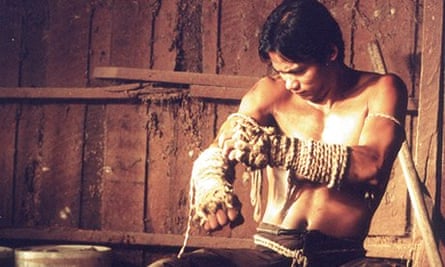
Hands and feet are one thing in martial arts; elbows and knees are quite another. And after seeing this Muay Thai showreel, you’d put money on Tony Jaa against any other screen fighter. Even in the scenes where Jaa isn’t fighting anyone at all, simply going through some moves, he’s awesomely formidable.
Ong Bak as a movie is fairly straightforward: city baddies steal a village’s Buddha head; a humble peasant goes to get it back, individually crushing each adversary with his bare hands in the process. That’s all it needs. Ong Bak’s prime objective is to say, “Can you believe this guy?” and with the added note that no special effects or stunt doubles were used, it more than accomplishes it. In fight after fight, Jaa unleashes moves that leave you thinking, “That’s gotta hurt”, if not “That’s gonna require major cranial reconstruction”. No holds are barred and few punches are pulled, but rather than brute violence, you’re left marvelling at Jaa’s speed, technique and pain threshold. The fights are skilfully staged, particularly an exhilarating, three-round barroom brawl that leaves no opponent or piece of furniture standing.
Jaa shows off his physical prowess in other ways, too, from an opening tree-climbing race to a Bangkok street chase that sends him along a hilarious assault course of cafe tables, market stalls, children, cars, trucks, sheets of glass and hoops of barbed wire. He’s almost too much to believe, and Ong Bak acknowledges our incredulity by frequently rewinding the action to show us Jaa’s moves in slow motion, as if to say, “Do you want to see that again?”. We do. SR
5. The Matrix
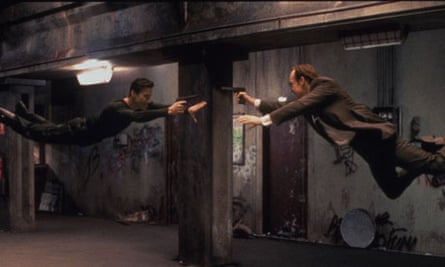
Cocteau imagined the mirror as a gateway to another world in his 1930 film The Blood of a Poet, and it’s a testament to the durability of this image that when it turned up again in The Matrix, it had lost none of its allure. The film clocks up a further debt in its plot, which proposes that what we perceive as reality is actually a cosmetic facade constructed to conceal a terrible truth about our existence. Neo, a computer boffin played by Keanu Reeves, is selected to bear the burden of enlightenment. Reeves’s blankness in the part is perfect, mainly because Neo is required to display only those skills and qualities that are downloaded into his brain. Required to master jujitsu, he is simply installed with the relevant computer programme. In no time at all, he is pulling off those tricks from 1970s martial arts movies, where a man can launch himself in a flying kick and somehow manage to prepare a cocktail, read a short novel and fill out his tax return, all before his feet touch the ground.
The film’s Cocteau-esque concept is harnessed to some X-Files-style paranoia, but it is the dazzling martial arts work that gives the film its special lift. The directors, the Wachowski brothers, were already having ideas above their station when they came up with The Matrix (their only previous film, after all, was the sweaty, claustrophobic thriller Bound). It was the martial arts choreographer Yuen Woo-ping who helped them reach the next level.
The movie’s fight sequences provide its purest source of pleasure for a number of reasons. First, the violence doesn’t come with redemptive overtones; it is played out for the thrill of the choreography, not the anticipation of injury or righteousness. Death is flippant, but it provides no moral kick. Second, the movie introduced a strange new effect, much copied or parodied since in everything from Charlie’s Angels to Shrek: a character freezes in midair while the camera circles the tableau like a computer imagining a 3D representation of a 2D image. When the camera has completed its movement, the physical motion of the scene resumes. Suddenly the humdrum vocabulary of the action movie has been extended before our disbelieving eyes. RG
4. House of Flying Daggers
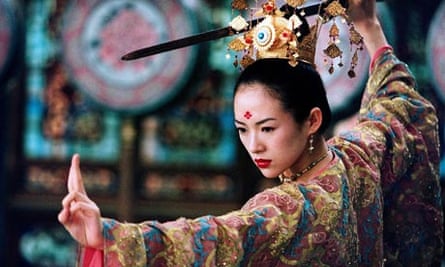
Watch the opening 20 minutes of House of Flying Daggers and it’s not hard to see why the Chinese picked its director, Zhang Yimou, to direct the opening ceremony of the Beijing Olympics. Even though the action unfolds within a reasonably sized brothel waiting room instead of a stadium, there’s all the elements that Zhang would multiply by the thousands in 2008: traditional Chinese music, dancing, swathes of brightly coloured silk cloth, drummers and, of course, martial arts. It makes for a magnificent spectacle that’s sets a high bar for the rest of the movie. Fortunately, there’s more dazzle to come in this follow-up to Zhang’s first wuxia film, Hero. Zhang’s 2006 Curse of the Golden Flower concluded the trilogy, but for many the romantic, operatic yet satisfyingly compact Flying Daggers represents the best of the three.
Set during the Tang dynasty, two police captains, Leo (Andy Lau, best known for the thematically-not-dissimilar Infernal Affairs trilogy) and Jin (hunky Takeshi Kaneshiro) are searching for the leader of the Flying Daggers, a counterinsurgency group. They suspect blind courtesan Mei (Zhang Ziyi) may be a secret member of the Daggers, so Jin, posing as a citizen, busts her out of jail and goes on the run with her, pursued by Leo and numerous expendable officers. Love seems to flower between Jin and Mei, but no one and nothing are as they seem here.
Although the fights are terrifically choreographed by Tony Ching Siu-tung – especially a bamboo-forest chase that tops Crouching Tiger, Hidden Dragon and a final mano-a-mano in the snow – judged against other classic martial arts films, Daggers is actually a little light on combat scenes. Indeed, the fighting is so stringently stylized it’s more like dancing with knives. No matter: the love story may be almost as schematic as the film’s rigorous use of colour, yet the acting is so powerful from the core trio that deep emotional depth is created seemingly out of nothing. Leslie Felperin
3. Police Story
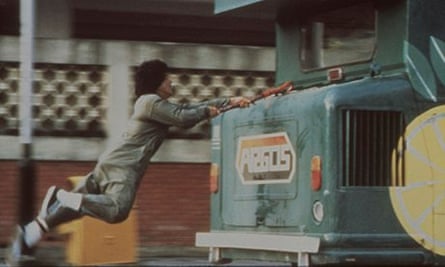
Although it was obvious at the time, it seems strange now that Jackie Chan was originally groomed by at least one Hong Kong producer as a successor to Bruce Lee, the lithe master of martial arts whose style was almost laughably serious in its grim-faced intensity. After a few tryouts in the genre, however, Chan took things in a much more comedic, but no less athletic route, which is why, after breaking out in the Yuen Woo-ping classic Drunken Master, the former stuntman found himself in Hollywood, adding light relief to The Cannonball Run in 1981.
Chan’s Hollywood career, however, didn’t pan out, and after a disappointment in 1985 with The Protector – a collaboration with neo-grindhouse director James Glickenhaus, perhaps not the most sympatico of all possible talents – Chan returned to Hong Kong to take matters into his own hands, directing and cowriting Police Story, in which he played a disgraced cop who is forced to go undercover and clear his name after being framed by drug barons.
Making a direct rebuttal of the Hollywood way of doing things (in his mind, sloppily and half-heartedly), Chan prioritised the fights and stuntwork, using the genre elements mostly as filler. Refusing to use a body double for every scene (bar one that involved a motorcycle), Chan began to earn his reputation as a fearless and pioneering action star. On this film alone, he was hospitalised with concussion, suffered severe burns, dislocated his pelvis and was almost paralysed by a shattered vertebrae. The resulting film was a huge hit and spawned five strong sequels. Seen now, it seems remarkably straight given what was to follow – the cartoonish Rush Hour series – although Chan certainly must have enjoyed the irony of being embraced by Hollywood for a film that is, essentially, a critique of everything it was doing wrong. DW
2. Crouching Tiger, Hidden Dragon
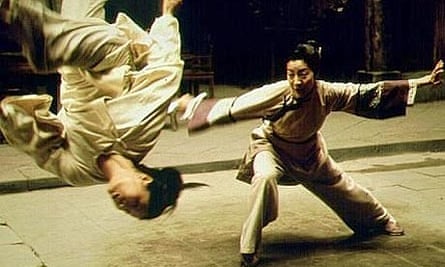
Why is Ang Lee’s film Crouching Tiger, Hidden Dragon such a sublime experience? Perhaps because every bone in your body tells you it shouldn’t work. It’s a tranquil action movie. Whoever heard of one of those? And it’s a love story with a kick: a kung-fu kick. It begins with the theft of a fabled sword, the Green Destiny. As the sword is stolen, the camera takes flight along with the thief, for whom gravity is a restricting garment to be cast off at a moment’s notice. The warrior Yu Shu Lien (Michelle Yeoh) gives chase, skipping blithely across rooftops that glow silver in the moonlight. When the pursuit gives way to combat, the rule book of action cinema is not only discarded but sliced to ribbons. For viewers too young to remember, the shock of seeing a Sam Peckinpah shoot-out back when slow motion was an innovation rather than a nasty virus, then the sight of these warriors levitating calmly to nosebleed-inducing heights will provide something of that same liberating jolt.
The midair skirmishes of martial arts movies were brought to mainstream audiences by The Matrix, and Lee enlisted that film’s choreographer, Yuen Woo-ping (who later worked on Kill Bill and Kung Fu Hustle), to take that style even further. The resulting fight routines evoke Olympic gymnastics, break dancing and those cartoon punch-ups where one of the Tasmanian Devil’s limbs would emerge briefly from within a frantic cyclone. And if Yu occasionally steps on her opponent’s foot, she’s not fighting dirty – it’s just the only way of ensuring that the battle remains at ground level.
For all the finesse of the choreography, the action sequences would be superficial without the emotional weight Lee brings to the picture, notably in the largely unspoken tenderness between Yu and her fellow warrior Li Mu Bai (Chow Yun Fat). As a director he doesn’t differentiate between the way he shoots tenderness and violence. In his hands, a love scene can come to be brutal, with a man’s blood forming a fork across his lover’s breast as they embrace, while a struggle between opponents in the forest treetops, with the supple branches doubling as nests, catapults, rungs and bungee ropes, achieves a sensuous serenity. RG
1. Enter the Dragon
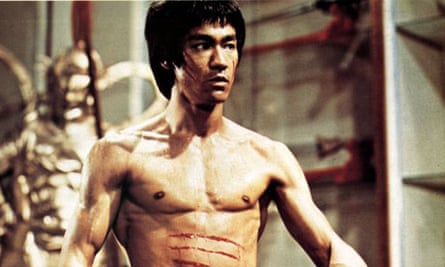
Bruce Lee purists may or may not agree that Enter the Dragon is his greatest film. But this is the one that has passed into legend: it was the colossal box office smash of 1973 and the most famous film of that unrivalled martial arts superstar who had died the summer before its release of a cerebral reaction to painkillers. He shared with James Dean the grim distinction of appearing posthumously in his most famous picture. After a career as a child star in Hong Kong cinema – almost the Macaulay Culkin of his day – and a spell on TV’s The Green Hornet, Lee exploded into action pictures that were simply so popular and profitable that Warner Brothers agreed to make Enter the Dragon, with Lee as star and coproducer: Hollywood’s first martial arts movie. Robert Clouse directed, and the script was by Michael Allin, who wrote the Isaac Hayes film Truck Turner. Lalo Schifrin composed the music.
Bruce Lee was possessed of extraordinary physical grace, balletic poise, lethal speed and explosive power. He was a master of kung fu, judo and karate, and is considered the spiritual godfather to today’s mixed martial arts scene. He was not a big man, and so his presence was better captured by the camera lens. Moreover, he had a delicately handsome, almost boyish face and had a charm and verbal fluency as he expounded his Zen theories of combat in interviews, something more like dynamic motivational philosophy than any fortune-cookie cliché. Lee had a presence and charisma comparable to Muhammad Ali, and that was perhaps never better captured than in Enter the Dragon. Perhaps only Jackie Chan now rivals him as an Asian star in Hollywood – and Hollywood has not shown much interest in promoting an Asian-American A-lister since Enter the Dragon.
Lee plays a Shaolin master who is recuited by British intelligence to enter a martial arts tournament undercover. This event is being run by a sinister megalomaniac called Han who is suspected of involvement in drugs and prostitution. Lee has a personal beef with Han, whose goons terrorised and attempted to rape Lee’s kid sister – she committed suicide rather than submit. He shows up at the island with a couple of American fighters: Williams, played by Jim Kelly, provides some Shaft-style street cred while Roper, played by John Saxon, is a playboy type who is close to the James Bond template. In truth, of course, it is Lee himself who is the James Bond, but he is no womaniser. Bruce Lee has a monkish purity and spirituality, with a laser-like focus on exposing Han – and of course kicking ass.
The look of the movie is exotic and extravagant, especially its inspired hall-of-mirrors showdown, with Lee sporting the weird, almost tribal slashes across his midriff. His strange, animal quavering cry and piercing gaze are entirely unique. But what makes Enter the Dragon outshine the rest is the serene, almost innocent idealism of Lee himself. In the opening scenes, Lee speaks humbly to the aged Abbot at his temple, coolly takes tea with the British intelligence chief Braithwaite, and interrupts their conversation to instruct a teenage boy in martial arts. When this young hothead is easily bested in combat, Lee says to him with inimitable seriousness: “We need emotional content – not anger.” It is the philosophy of this martial arts classic, and its unique star. Peter Bradshaw

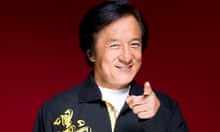

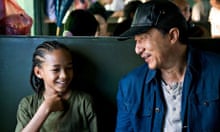
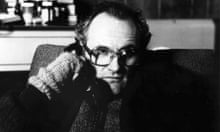



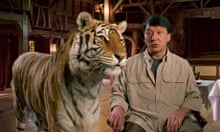
Comments (…)
Sign in or create your Guardian account to join the discussion